 Welcome To Nefer's
Welcome To Nefer's
Great Pyramid
&
Ra Math Lesson 8


 Of Wonders
Of Wonders





 FIBONACCI
FIBONACCI
I gained a stronger understanding of the Ra System of Mathematics in
the fall of 1975, when I realized that 12 x 13.5 Hz. (last elf and alpha
brain wave frequency) equaled 162. Written as 1.62 this number is very close
in value to 1.618033989 which is well known in the realm of mathematics
by the Greek letter phi
The person who is credited with our present day knowledge of this number,
was known as Leonardo Biggolo Fibonacci.
Fibonacci was born in Pisa, Italy in 1179. As a young man he traveled to
North Africa (including Egypt) with his father who was a merchant. During
his travels Fibonacci learned of the Hindu system of numerals 1 to 9 and
0. After introducing these numbers to Europe they quickly replaced cumbersome
Greek letters and Roman numerals as symbols in mathematical calculations.
While in Egypt Fibonacci learned of and additive series of numbers. This
series and others based on it, are now referred to individually as a "Fibonacci
series."
Each new number in a Fibonacci series is the sum of the previous two.i.e.
1-2-3-5-8-13-21 ect..
Here is a curious property of Fibonacci numbers. Pick any three numbers
that follow each other in line. Square the middle number and multiply the
first number by the third. For example if we take the numbers 3 - 5 and
8 we get: 5 x 5 = 25 and 3 x 8 = 24 (there will be a difference of 1 in
every case).
The ratio that exists between any two successive Fibonacci number grows
as the numbers become greater in value. Eventually the ratio reaches 1.618033989
(phi) and then the series ends. The ratio between the next two Fibonacci
numbers and each pair thereafter remains constantly at 1.618033989 (phi).
The number 1.618033989 has been assigned the capital symbol of the Greek
letter phi which is:  . The decimal portion of the number (.618033989)
is generally symbolized by the lower case version of the letter (
. The decimal portion of the number (.618033989)
is generally symbolized by the lower case version of the letter ( ).
).
Phi is an interesting number without rival. It is said to be the only number
that has a reciprocal which is equal to its own fractional part.
(1) 1 / 1.618033989 = .618033989
Another mathematical fact concerning phi that is also quite unique is stated
below:
(2)  (1 plus phi equals phi squared) :
(1 plus phi equals phi squared) :
There is a formula for calculating phi. The directions are: Subtract
1 from the square root of 5, divide the result by 2 and then add 1.
When Fibonacci was asked why he studied these numbers and their ratios he
replied: "Someday these numbers will unlock the secrets of nature and
will explain why a drone bee does not have a father." it is evident
by this statement that Fibonacci was aware that phi and its associated Fibonacci
numbers are found expressed in the shapes and proportions of life forms
such as: humans animals and plants.


To show how the Fibonacci ratios reflect in nature let us look at the
way leaves grow and become positioned on the stems of various plants.
When new leaves grow from a plant, they grow in a spiral around the plant's
stem. Nature spaces the leaves in this way so that higher leaves do not
shade the lower leaves too much from sunlight.
The number of turns in the spiral (from leaf to leaf) and the number of
leaves that exist in the pattern in all cases express a Fibonacci fraction
and therefore a Fibonacci ratio. The same pattern repeats again and again
as the plant grows.
The illustration that follows explains how to find the Fibonacci fractions
and ratios of various plants:







Pine cones have the ratios of 5/8 and 8/13, where as daisies have the
Fibonacci ratio of 21/34.
To date I have not located any work that catalogs plants by their Fibonacci
ratios. I believe this type of plant classification (which most likely exists)
may some day assist in in formulating various derivatives of plants in to
new, useful medicines and chemical compounds.

 THE PHI PROPORTION / SACRED CUT
THE PHI PROPORTION / SACRED CUT 
Phi can be physically determined with a straight edge and a draftsman's
compass. if you split two squares in half and place one point of the compass
directly on the center of the base line of the first square (blue in the
illustration) and then place the other point of the compass where the upper
right corner of the blue square meets the upper left corner
of the red section of the second square, the sacred cut can be produced
by swinging this compass point down in an arc. The point
where the arc crosses the base line of the second square will be exactly
.618 units from the common border of the blue and red squares. See following
illustration:





 GOLDEN TRIANGLE AND 5 POINTED STAR
GOLDEN TRIANGLE AND 5 POINTED STAR


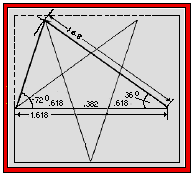


The 5 pointed star or pentagram is formed on the order of the phi proportion
(sacred cut). The pentagram was the logo of the Pythagorean school of mathematics.

 STAR FISH
STAR FISH 
The starfish is also phi proportioned as is the pentagram (shown
above). The phi proportioning of the form of a starfish might relate to
the fact that the animal can regenerate a limb after one has been severed
from its body.


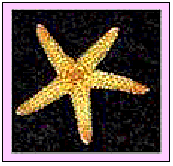


The illustration below depicts how the human body is phi proportioned.
Fibonacci ratios are present in the spacing of the knuckles and wrist joint
of the average hand, as well as the numerous bones in the foot







The human brain produces more alpha brain waves of 10.602875 red cycles
per natural second of time than alpha brain waves of any other frequency
and that 13.5 red cycles per natural second of time is the last frequency
of the alpha range. It was also shown in earlier articles that 1.0602875
units is the red format value for H-Bar and the Ra linear unit of measure
called the "Hunab." 10.602875 / 13.5 = .78539814 - - - (1/4 red
pi). this result suggests that our bodies are proportioned on the order
of phi and our brain wave activity is regulated by at least 1/4 the value
of pi. This pi relationship might be the reason that we are able to intelligently
think and reason, where as animal bodies are also proportion on the order
of phi, their brain functions are regulated by a Fibonacci ratio that is
indicative to an animal's particular species.
A person who attains the ability to use the infinite value of pi in their
thoughts and perceptions would then be capable of having what is called
the "infinite thought" or have the ability of "cosmic consciousness"
which is also the ultimate form of extrasensory perception. For further
information regarding this subject see forthcoming link from this site titled:
The Universal Life Field and the Levels of Perception.


 PHI IN ELECTRICAL ENGINEERING
PHI IN ELECTRICAL ENGINEERING 




In electrical engineering the Fibonacci numbers occur. For example,
if a series unit
resistances are connected alternately in series and in parallel, as shown
in Figure 2 A the resistances of the entire circuit is expressed by the
continued fraction:






For successively larger number of resistances, the value of R is:



In accordance with the Fibonacci series., if the first resistance in
the circuit is in parallel instead of series, as in figure 2 B, the initial
term in the equation for R is omitted and successive values for R/r become:





Electrical activity that produce brain waves in the human brain
which have a relationship to the value of pi might be regulated
by biological resistance factors that are related to the value of phi. Pi
x Phi = Ankh (life), see dimensions of G.P.
One might have to overcome these possible biological resistance
factors by some form of thinking (?) in order to achieve the use of the
full value of pi in their thought processes.


 THE FIBONACCI LOGARITHMIC SPIRAL
THE FIBONACCI LOGARITHMIC SPIRAL 





The natural form of a Fibonacci logarithmic spiral is created accurately
in the illustration above when the spiral form is dictated by the corners
of successive larger or smaller (viewed either way) phi proportions.
Many forms of life express the Fibonacci spiral in their shells and protective
horns. Many fossils of life now extinct, had shells that were shaped in
the form of Fibonacci spirals.
The snail is one of the oldest known forms of life. Fossils of the snail
exist from the time of the beginning of the Ordovician Period, that existed
between 440 and 500 million years ago.



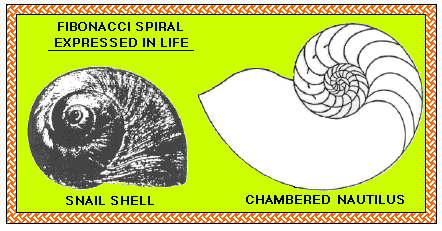



The exterior surface of the shell of a chambered nautilus is in the
form of the Fibonacci spiral. A cross section of a mature nautilus reveals
27 chambers.
A male sheep (ram) exquisitely displays the Fibonacci spiral in the form
of its horns. The sheep is known to have 27 pairs of chromosomes in its
biological make up. Remember there are also 27 Ra repitans.







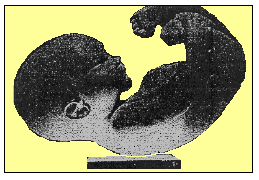



The human fetus develops along the lines of a Fibonacci spiral.
The choclea is a Fibonacci spiral shaped organ located in the inter ear.



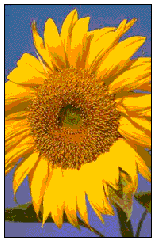



The sunflower is so named because it physically turns its face toward
the sun from dawn to sunset. This action, in my opinion is due to the fact
that the plant's flower structure has a unique relationship to phi.
The seeds of the sunflower are arranged with precise uniformity in curved
lines radiating in spokes from its center. Some of the curves turn left
and these are crossed by those that turn right. The curves are Fibonacci
spirals and the ratio of those going clockwise to those going counter clockwise
is always 1.618033989, or phi. Therefore the sunflower's ratio is exactly
the value of phi (1.62) which is the base line of the following graph. Plants
with other Fibonacci ratios would be located at other points on the graph.




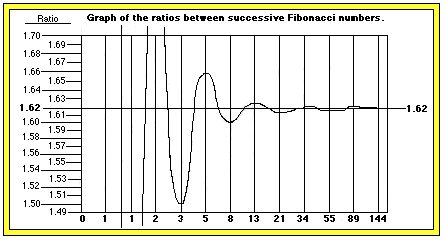



The Passages and Chambers of The Great Pyramid




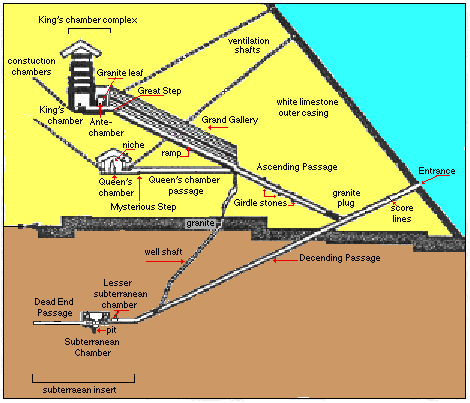



Please refer to the illustration above as you read the following description
of the passages and chambers of the Great Pyramid.
The passage that leads downward from the pyramid's entrance is called the
"Descending Passage." At the lower end of the Descending Passage
is a "Short Horizontal Passage" that leads into a room which has
been named the "Subterranean Chamber." From the Subterranean Chamber
to the South runs another horizontal passage that comes to a dead end.
This passage is appropriately called the "Dead End Passage."
The upward running passage that stems from the Descending Passage is called
"The Ascending Passage." This passage connects to "The Horizontal
Passage to The Queen's Chamber." This horizontal passage contains,
on its far end, a step that has been given the name: 'The Mysterious Step."
The room at the end of the Horizontal Passage is identified as the "Queen's
Chamber." Please take note of the fact, that this chamber has a pointed
ceiling .
The upward running passage that intersects at its bottom, with both the
Ascending Passage and the Horizontal Passage to the Queen's Chamber is called
" The Grand Gallery."
The upper end of the Grand Gallery meets with a large step that is called
the "Great Step." I am of the belief that the Great Step is actually
a "hatch" that if opened would lead to other passages and chambers.
From the Great Step a "Small Horizontal Passage" enters an "Ante-Chamber."
The grooved walls of this chamber probably held sliding slabs of stone that
acted as counter weights for the Great Step (hatch).
At the Ante- Chamber's far end is another "Short Horizontal Passage"
that in turn enters " The King's Chamber." In the King"s
Chamber is found the granite box which is called the "Coffer."
There are 5 " Relieving Chambers " situated above the King's Chamber.
The upper most of these chambers has a pointed ceiling.
At the bottom of the Grand Gallery there is a crudely dug shaft that travels
an indirect path to a point that intersects the Descending Passage near
its lower end. This shaft is called " The Well Shaft ."
During its course the Well Shaft enters and leaves a room like area that
is called "The Grotto." The Well Shaft upper end terminates at
the western base of the Grand Gallery and its lower end teminates near the
bottom of the Descending Passage.


THE GREAT PYRAMID AND THE FIBONACCI SPIRAL
The following illustration depicts a cross-section of the Great Pyramid
which reveals the structure's known internal passages and chambers.
I have superimposed the Fibonacci Spiral over the pyramid's
inner features.








In my opinion this procedure has revealed that the architect planned
all of the passages and chambers from the beginning to conform to the shape
of a Fibonacci Spiral. This opinion is based on the following deductions:
1 (A ): The pointed ceiling of the uppermost relieving
chamber (above the King's Chamber) is even with the highest point in the
spiral's curve. The pointed ceiling of the relieving chamber and that of
the Queen's Chamber, may have acted as architectural points of reference
during the pyramid's construction. Very much like indication arrows in an
architectural drawing.
2: The pointed ceiling of the Queen's Chamber points to the center of the
spiral. Which is logically the location of a yet undiscovered passage or
chamber.
3 (B ): Following the curve of the spiral to the right,
it precisely separates The Grand Gallery from the Ascending Passage.
4 (D ): Following the curve of the spiral further on to
the right, it can be seen that it passes through the Subterranean Chamber
and bottoms out on the floor of the Dead End Passage before it again turns
upward. This is obviously the reason that this passage was built in the
first place.
5 (F ) : The line that is projected from the center of
the spiral down to the corner of the Phi proportioned square just clears
the ceiling of the Queen's Chamber and intersects the Horizontal Passage
to the Queen's Chamber at the exact location of the Mysterious Step.
6 (C ) : The Well Shaft to and from the Grotto was cut
just inside of the spiral line. The spiral line crosses the Well Shaft precisely
at the point where the shaft takes an abrupt turn downward.
Deduction number 6 indicates that whoever dug the Well Shaft was aware of
the existence and location of the invisible spiral outline.
In the bedrock beneath the pyramid are a number of fissures (wide cracks).
Notice, that the spiral line passes through two of the major fissures, as
does the Well Shaft.
Theoretically the pyramid may have had a dynamic function, which was the
generation of a force in the shape of a Fibonacci Spiral. Continuing on
in a theoretical sense, this force might have caused the fissures in the
bedrock below the structure. Because of this, the Well Shaft might have
been dug to dampen the force and thus stop any new fissures from manifesting,
or those existing fissures from becoming larger.
The place marked by an X in the illustration is the location
where a Egyptian and French team drilled a slanted hole in the west wall
of the Horizontal Passage. They stopped drilling when they began to penetrate
a wall of Turah limestone. There will be more said about this subject later
on in this writing.


THE GRAND GALLERY, AND THE ASCENDING AND HORIZONTAL
PASSAGES OF THE GREAT PYRAMID OF
GIZA
The information that follows should definitely remove all doubt that
the builders of the Great Pyramid of Giza were highly advanced and used
the natural Ra System of Mathematics in their structure's geometrical design.





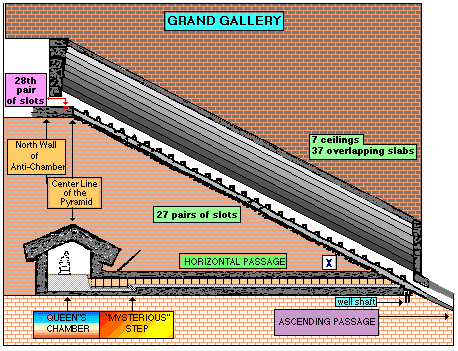



 THE GRAND GALLERY
THE GRAND GALLERY
The Grand Gallery is rightfully considered to be an architectural marvel.
Its full length is just under 158. British feet. There are several features
of this gallery that play major roles in the description of the total mathematical
message of the pyramid.
The Grand Gallery has 7 ceilings that once were composed of 37 individual
over lapping stone slabs. This was a very ambitious physical undertaking
if the pyramid was built to serve only as a tomb. One ceiling would have
certainly served the purpose.
It has been determined that the 7 ceilings of the Grand Gallery represent
the 7 periods of the "periodic table of the elements" or electron
shells " K to Q." The 37 over lapping stone slabs each represent
fractions of the number 37. or: .027 - .054- 81- 135 ect. . This is where
I acquired the knowledge of the 37 values for the Ra Table of Nines.
When we consider that the omega major values for the Ra table of Nines (T.O.N.)
also relate to the omega major values of the wave lengths of the spectral
lines that are emitted the by the elements, along with the fact that the
37 slabs are found as components of the 7 ceilings (7 electron shells) the
message of the 7 ceilings and 37 overlaps becomes clear.
The Grand Gallery has curbs (banquettes) that run the length of the gallery's
ramp. In these curbs are found 27 pairs of slots which are evenly spaced
apart. These slots of course represent the 27 Ra repitans. Where as the
7 ceilings and 37 over laps represent electron activity the 27 repitans
represent factors that pertain to the functions of atomic nuclei. The idea
that the repitans represent mathematical descriptions of "quarks"
is supported here.
The 37 over lapping stone slabs situated over the 27 slots suggests the
fraction 37 / 27 or 1.370370 - - - (999. fine structure units).
There is a 28th pair of slots that are located in the platform (Great Step)
located at the top of the Grand Gallery. This pair of slots represents the
000 - - - repitan. Notice, that this pair of slots is located directly above
the center of the Fibonacci spiral that was superimposed over a cross section
of the pyramid , as seen in an earlier illustration. I believe that this
is an indication that an undiscovered passage or chamber exists beneath
the Great Step and at the center of the spiral (centered about 24 feet to
the west in the pyramid where the north -south axis and east -west axis
cross).

The length of the Grand Gallery in 5 of the Ra formats is seen in the following
chart.






I will refer to omega major values for the length of the gallery in
order to describe the following facts: 1,875.00 omega major inches / 50625.
 = .037037 - - - (first Ra repitan or 1 / 27).
= .037037 - - - (first Ra repitan or 1 / 27).
If the length of the gallery in omega major inches is divided by 27 we obtain
the length of the distance that exists between the slots: 69.444 - - - omega
major inches. If this length is divided by 50625. the result is:
.001371742 (fine structure constant for hydrogen).
the result is:
.001371742 (fine structure constant for hydrogen).
The lengths of the "Horizontal Passage to the Queen's Chamber"
and the "Ascending Passage" are presented below. This is done
so that their particular lengths can be compared to the length of the Grand
Gallery.
The length of the Horizontal Passage in 5 of the Ra formats are seen in
the following chart.






Notice that the passage length in Ra feet is equal to the number of
units that are in the diameter of the Ra Circle (respective to the various
formats shown). This passage length is actually 1/6 the length of the pyramid's
base.
The length of the Ascending Passage in 5 of the Ra formats are seen in the
following chart.



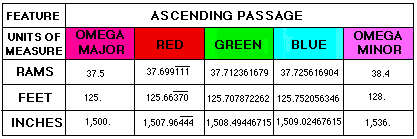


When the length of the Grand Gallery is divided by the length of the
Horizontal Passage the result is the Ra plus sequence 1.234567m901.
When the length of the Ascending Passage is divided by the length of the
Horizontal Passage the result is the Ra minus sequence 9.87654321 (square
of green pi).
For more detailed information regarding these passages of the Great Pyramid
see "The Rods of Amon Ra."
In the illustration of the Grand Gallery and Horizontal Passage shown earlier
near the beginning of the Horizontal Passage is found an "X" .
It was at this location that the Egyptian- French archaeological team (mentioned
earlier) drilled a hole at a slant in the west wall of the passage. The
team stopped their drilling after they struck a fine quality Turah limestone.
This type of limestone was generally used in the walls of chambers. The
22 acres of casing stones that once covered the outer surfaces of the pyramid
were of Turah limestone. The "x" is located on the first phi cut
shown in the earlier illustration that depicts the superimposer of a Fibonacci
Spiral over the features of the pyramid's cross section.
It is believed that the French actually drilled in to the wall of a previously
undiscovered chamber. In response to a request from the Egyptian Antiquities
Organization to assist in devising a means to gain access to the possible
chamber without doing damage to the pyramid, I proposed the following: Because
the walls of the Horizontal Passage do not rest on the blocks that compose
the floor of the passage, the floor blocks could be moved one at a time
in the direction of the Queen's Chamber (starting with the block called
the Mysterious Step). As the floor blocks are moved as stated, the areas
beneath them could be examined for a possible rubble filled shaft that might
lead to any number of undiscovered passages and chambers. Failing to fine
such a shaft, the flooring blocks could be resituated at their original
positions.
I also believe that access routes, that lead to yet undiscovered passages
and chambers will be found under the "Great Step" located at the
top of the Grand Gallery and also behind the walls that exist between the
"Girdle Stones" of the Ascending Passage.
At this point any person who does not believe that the known passages and
chambers of the Great Pyramid were deliberately located to conform to the
shape of a Fibonacci Spiral, or that the stuctrure was built on the order
of the Ra System of Mathematics, should in my opinion, report immediately
to their nearest mental health facility.
The undeniable fact that the Ra System was used in the construction of the
Great Pyramid and other ancient buildings located elsewhere in the world
has baffled the recognized authorities. To date they have chosen to ignore
and stonewall this information. Maybe they are hoping it will disappear
from the mainstream of human knowledge, as it did so many thousands of years
ago?


 Copyright 1987. By Wesley H. Bateman. All rights reserved.
Copyright 1987. By Wesley H. Bateman. All rights reserved.























 Nefers Home Page
Nefers Home Page Ra
Math Snowflake Lesson
Ra
Math Snowflake Lesson Fine
Structure Constant Lesson 9
Fine
Structure Constant Lesson 9